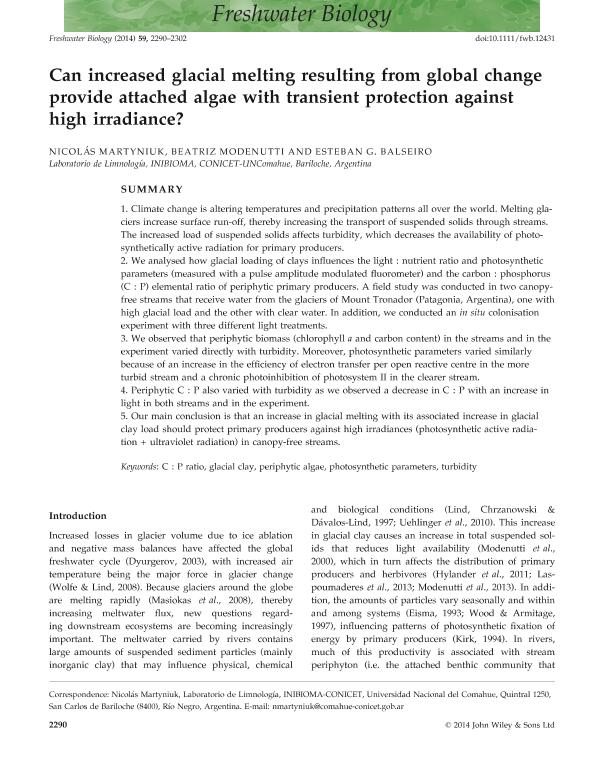Mostrar el registro sencillo del ítem
dc.contributor.author
Martyniuk, Nicolás Alejandro

dc.contributor.author
Modenutti, Beatriz Estela

dc.contributor.author
Balseiro, Esteban Gabriel

dc.date.available
2017-01-26T21:05:21Z
dc.date.issued
2014-11
dc.identifier.citation
Martyniuk, Nicolás Alejandro; Modenutti, Beatriz Estela; Balseiro, Esteban Gabriel; Can increased glacial melting resulting from global change provide attached algae with transient protection against high irradiance?; Wiley Blackwell Publishing, Inc; Freshwater Biology (print); 59; 11; 11-2014; 2290-2302
dc.identifier.uri
http://hdl.handle.net/11336/12057
dc.description.abstract
Climate change is altering temperatures and precipitation patterns all over the world. Melting glaciers increase surface run-off, thereby increasing the transport of suspended solids through streams. The increased load of suspended solids affects turbidity, which decreases the availability of photosynthetically active radiation for primary producers.
2. We analysed how glacial loading of clays influences the light : nutrient ratio and photosynthetic parameters (measured with a pulse amplitude modulated fluorometer) and the carbon : phosphorus (C : P) elemental ratio of periphytic primary producers. A field study was conducted in two canopyfree streams that receive water from the glaciers of Mount Tronador (Patagonia, Argentina), one with high glacial load and the other with clear water. In addition, we conducted an in situ colonisation experiment with three different light treatments.
3. We observed that periphytic biomass (chlorophyll a and carbon content) in the streams and in the experiment varied directly with turbidity. Moreover, photosynthetic parameters varied similarly because of an increase in the efficiency of electron transfer per open reactive centre in the more turbid stream and a chronic photoinhibition of photosystem II in the clearer stream.
4. Periphytic C : P also varied with turbidity as we observed a decrease in C : P with an increase in light in both streams and in the experiment.
5. Our main conclusion is that an increase in glacial melting with its associated increase in glacial clay load should protect primary producers against high irradiances (photosynthetic active radiation + ultraviolet radiation) in canopy-free streams.
dc.format
application/pdf
dc.language.iso
eng
dc.publisher
Wiley Blackwell Publishing, Inc

dc.rights
info:eu-repo/semantics/openAccess
dc.rights.uri
https://creativecommons.org/licenses/by-nc-sa/2.5/ar/
dc.subject
C : P Ratio
dc.subject
Glacial Clay
dc.subject
Periphytic Algae
dc.subject
Photosynthetic Parameters
dc.subject
Turbidity
dc.subject.classification
Ecología

dc.subject.classification
Ciencias Biológicas

dc.subject.classification
CIENCIAS NATURALES Y EXACTAS

dc.title
Can increased glacial melting resulting from global change provide attached algae with transient protection against high irradiance?
dc.type
info:eu-repo/semantics/article
dc.type
info:ar-repo/semantics/artículo
dc.type
info:eu-repo/semantics/publishedVersion
dc.date.updated
2016-12-12T14:23:41Z
dc.identifier.eissn
1365-2427
dc.journal.volume
59
dc.journal.number
11
dc.journal.pagination
2290-2302
dc.journal.pais
Estados Unidos

dc.journal.ciudad
Hoboken
dc.description.fil
Fil: Martyniuk, Nicolás Alejandro. Consejo Nacional de Investigaciones Científicas y Técnicas. Centro Científico Tecnológico Patagonia Norte. Instituto de Investigación En Biodiversidad y Medioambiente; Argentina. Universidad Nacional del Comahue. Centro Reg.universidad Bariloche. Laboratorio de Limnologia; Argentina
dc.description.fil
Fil: Modenutti, Beatriz Estela. Consejo Nacional de Investigaciones Científicas y Técnicas. Centro Científico Tecnológico Patagonia Norte. Instituto de Investigación En Biodiversidad y Medioambiente; Argentina. Universidad Nacional del Comahue. Centro Reg.universidad Bariloche. Laboratorio de Limnologia; Argentina
dc.description.fil
Fil: Balseiro, Esteban Gabriel. Consejo Nacional de Investigaciones Científicas y Técnicas. Centro Científico Tecnológico Patagonia Norte. Instituto de Investigación En Biodiversidad y Medioambiente; Argentina. Universidad Nacional del Comahue. Centro Reg.universidad Bariloche. Laboratorio de Limnologia; Argentina
dc.journal.title
Freshwater Biology (print)

dc.relation.alternativeid
info:eu-repo/semantics/altIdentifier/doi/http://dx.doi.org/10.1111/fwb.12431
dc.relation.alternativeid
info:eu-repo/semantics/altIdentifier/url/http://onlinelibrary.wiley.com/doi/10.1111/fwb.12431/abstract
Archivos asociados
